Saturday, July 26, 2014
Five Israeli Talking Points on Gaza—Debunked
July 25, 2014
Smoke from an Israeli strike rises over the Gaza Strip. (AP, Hatem Moussa)
Israel has killed almost 800 Palestinians in the past twenty-one days in the Gaza Strip alone; its onslaught continues. The UN estimates that more than 74 percent of those killed are civilians. That is to be expected in a population of 1.8 million where the number of Hamas members is approximately 15,000. Israel does not deny that it killed those Palestinians using modern aerial technology and precise weaponry courtesy of the world’s only superpower. In fact, it does not even deny that they are civilians.
Israel’s propaganda machine, however, insists that these Palestinians wanted to die (“culture of martyrdom”), staged their own death (“telegenically dead”) or were the tragic victims of Hamas’s use of civilian infrastructure for military purposes (“human shielding”). In all instances, the military power is blaming the victims for their own deaths, accusing them of devaluing life and attributing this disregard to cultural bankruptcy. In effect, Israel—along with uncritical mainstream media that unquestionably accept this discourse—dehumanizes Palestinians, deprives them even of their victimhood and legitimizes egregious human rights and legal violations.
This is not the first time. The gruesome images of decapitated children’s bodies and stolen innocence on Gaza’s shores are a dreadful repeat of Israel’s assault on Gaza in November 2012 and winter 2008–09. Not only are the military tactics the same but so too are the public relations efforts and the faulty legal arguments that underpin the attacks. Mainstream media news anchorsare inexplicably accepting these arguments as fact.
Below I address five of Israel’s recurring talking points. I hope this proves useful to newsmakers.
1) Israel is exercising its right to self-defense.
As the occupying power of the Gaza Strip, and the Palestinian Territories more broadly, Israel has an obligation and a duty to protect the civilians under its occupation. It governs by military and law enforcement authority to maintain order, protect itself and protect the civilian population under its occupation. It cannot simultaneously occupy the territory, thus usurping the self-governing powers that would otherwise belong to Palestinians, and declare war upon them. These contradictory policies (occupying a land and then declaring war on it) make the Palestinian population doubly vulnerable.
The precarious and unstable conditions in the Gaza Strip from which Palestinians suffer are Israel’s responsibility. Israel argues that it can invoke the right to self-defense under international law as defined in Article 51 of the UN Charter. The International Court of Justice, however, rejected this faulty legal interpretation in its 2004 Advisory Opinion. The ICJ explained that an armed attack that would trigger Article 51 must be attributable to a sovereign state, but the armed attacks by Palestinians emerge from within Israel’s jurisdictional control. Israel does have the right to defend itself against rocket attacks, but it must do so in accordance with occupation law and not other laws of war. Occupation law ensures greater protection for the civilian population. The other laws of war balance military advantage and civilian suffering. The statement that “no country would tolerate rocket fire from a neighboring country” is therefore both a diversion and baseless.
Israel denies Palestinians the right to govern and protect themselves, while simultaneously invoking the right to self-defense. This is a conundrum and a violation of international law, one that Israel deliberately created to evade accountability.
2) Israel pulled out of Gaza in 2005.
Israel argues that its occupation of the Gaza Strip ended with the unilateral withdrawal of its settler population in 2005. It then declared the Gaza Strip to be “hostile territory” and declared war against its population. Neither the argument nor the statement is tenable. Despite removing 8,000 settlers and the military infrastructure that protected their illegal presence, Israel maintained effective control of the Gaza Strip and thus remains the occupying power as defined by Article 47 of the Hague Regulations. To date, Israel maintains control of the territory’s air space, territorial waters, electromagnetic sphere, population registry and the movement of all goods and people.
Israel argues that the withdrawal from Gaza demonstrates that ending the occupation will not bring peace. Some have gone so far as to say that Palestinians squandered their opportunity tobuild heaven in order to build a terrorist haven instead. These arguments aim to obfuscate Israel’s responsibilities in the Gaza Strip, as well as the West Bank. As Prime Minister Netanyahu once explained, Israel must ensure that it does not “get another Gaza in Judea and Samaria…. I think the Israeli people understand now what I always say: that there cannot be a situation, under any agreement, in which we relinquish security control of the territory west of the River Jordan.”
Palestinians have yet to experience a day of self-governance. Israel immediately imposed a siege upon the Gaza Strip when Hamas won parliamentary elections in January 2006 and tightened it severely when Hamas routed Fatah in June 2007. The siege has created a “humanitarian catastrophe” in the Gaza Strip. Inhabitants will not be able to access clean water, electricity or tend to even the most urgent medical needs. The World Health Organization explains that the Gaza Strip will be unlivable by 2020. Not only did Israel not end its occupation, it has created a situation in which Palestinians cannot survive in the long-term.
3) This Israeli operation, among others, was caused by rocket fire from Gaza.
Israel claims that its current and past wars against the Palestinian population in Gaza have been in response to rocket fire. Empirical evidence from 2008, 2012 and 2014 refute that claim. First, according to Israel’s Ministry of Foreign Affairs, the greatest reduction of rocket fire came through diplomatic rather than military means. This chart demonstrates the correlation between Israel’s military attacks upon the Gaza Strip and Hamas militant activity. Hamas rocket fire increases in response to Israeli military attacks and decreases in direct correlation to them. Cease-fires have brought the greatest security to the region.
During the four months of the Egyptian-negotiated cease-fire in 2008, Palestinian militants reduced the number of rockets to zero or single digits from the Gaza Strip. Despite this relative security and calm, Israel broke the cease-fire to begin the notorious aerial and ground offensive that killed 1,400 Palestinians in twenty-two days. In November 2012, Israel’s extrajudicial assassination of Ahmad Jabari, the chief of Hamas’s military wing in Gaza, while he was reviewing terms for a diplomatic solution, again broke the cease-fire that precipitated the eight-day aerial offensive that killed 132 Palestinians.
Immediately preceding Israel’s most recent operation, Hamas rocket and mortar attacks did not threaten Israel. Israel deliberately provoked this war with Hamas. Without producing a shred of evidence, it accused the political faction of kidnapping and murdering three settlers near Hebron. Four weeks and almost 700 lives later, Israel has yet to produce any evidence demonstrating Hamas’s involvement. During ten days of Operation Brother’s Keeper in the West Bank, Israel arrested approximately 800 Palestinians without charge or trial, killed nine civilians and raided nearly 1,300 residential, commercial and public buildings. Its military operation targeted Hamas members released during the Gilad Shalit prisoner exchange in 2011. It’s these Israeli provocations that precipitated the Hamas rocket fire to which Israel claims left it with no choice but a gruesome military operation.
4) Israel avoids civilian casualties, but Hamas aims to kill civilians.
Hamas has crude weapons technology that lacks any targeting capability. As such, Hamas rocket attacks ipso facto violate the principle of distinction because all of its attacks are indiscriminate. This is not contested. Israel, however, would not be any more tolerant of Hamas if it strictly targeted military objects, as we have witnessed of late. Israel considers Hamas and any form of its resistance, armed or otherwise, to be illegitimate.
In contrast, Israel has the eleventh most-powerful military in the world, certainly the strongest by far in the Middle East, and is a nuclear power that has not ratified the non-proliferation agreement and has precise weapons technology. With the use of drones, F-16s and an arsenal of modern weapon technology, Israel has the ability to target single individuals and therefore to avoid civilian casualties. But rather than avoid them, Israel has repeatedly targeted civilians as part of its military operations.
The Dahiya Doctrine is central to these operations and refers to Israel’s indiscriminate attacks on Lebanon in 2006. Maj. Gen. Gadi Eizenkot said that this would be applied elsewhere:
What happened in the Dahiya quarter of Beirut in 2006 will happen in every village from which Israel is fired on. […] We will apply disproportionate force on it and cause great damage and destruction there. From our standpoint, these are not civilian villages, they are military bases.
Israel has kept true to this promise. The 2009 UN Fact-Finding Mission to the Gaza Conflict, better known as the Goldstone Mission, concluded “from a review of the facts on the ground that it witnessed for itself that what was prescribed as the best strategy [Dahiya Doctrine] appears to have been precisely what was put into practice.”
According to the National Lawyers Guild, Physicians for Human Rights-Israel, Human Rights Watch and Amnesty International, Israel directly targeted civilians or recklessly caused civilian deaths during Operation Cast Lead. Far from avoiding the deaths of civilians, Israel effectively considers them legitimate targets.
5) Hamas hides its weapons in homes, mosques and schools and uses human shields.
This is arguably one of Israel’s most insidious claims, because it blames Palestinians for their own death and deprives them of even their victimhood. Israel made the same argument in its war against Lebanon in 2006 and in its war against Palestinians in 2008. Notwithstanding its militarycartoon sketches, Israel has yet to prove that Hamas has used civilian infrastructure to storemilitary weapons. The two cases where Hamas indeed stored weapons in UNRWA schools, the schools were empty. UNRWA discovered the rockets and publicly condemned the violation of its sanctity.
International human rights organizations that have investigated these claims have determined that they are not true. It attributed the high death toll in Israel’s 2006 war on Lebanon to Israel’s indiscriminate attacks. Human Rights Watch notes:
The evidence Human Rights Watch uncovered in its on-the-ground investigations refutes [Israel’s] argument…we found strong evidence that Hezbollah stored most of its rockets in bunkers and weapon storage facilities located in uninhabited fields and valleys, that in the vast majority of cases Hezbollah fighters left populated civilian areas as soon as the fighting started, and that Hezbollah fired the vast majority of its rockets from pre-prepared positions outside villages.
In fact, only Israeli soldiers have systematically used Palestinians as human shields. Since Israel’s incursion into the West Bank in 2002, it has used Palestinians as human shields by tying young Palestinians onto the hoods of their cars or forcing them to go into a home where a potential militant may be hiding.
Even assuming that Israel’s claims were plausible, humanitarian law obligates Israel to avoid civilian casualties that “would be excessive in relation to the concrete and direct military advantage anticipated.” A belligerent force must verify whether civilian or civilian infrastructure qualifies as a military objective. In the case of doubt, “whether an object which is normally dedicated to civilian purposes, such as a place of worship, a house or other dwelling or a school, is being used to make an effective contribution to military action, it shall be presumed not to be so used.”
In the over thee weeks of its military operation, Israel has demolished 3,175 homes, at least a dozen with families inside; destroyed five hospitals and six clinics; partially damaged sixty-four mosques and two churches; partially to completely destroyed eight government ministries; injured 4,620; and killed over 700 Palestinians. At plain sight, these numbers indicate Israel’s egregious violations of humanitarian law, ones that amount to war crimes.
Beyond the body count and reference to law, which is a product of power, the question to ask is, What is Israel’s end goal? What if Hamas and Islamic Jihad dug tunnels beneath the entirety of the Gaza Strip—they clearly did not, but let us assume they did for the sake of argument. According to Israel’s logic, all of Gaza’s 1.8 million Palestinians are therefore human shields for being born Palestinian in Gaza. The solution is to destroy the 360-kilometer square strip of land and to expect a watching world to accept this catastrophic loss as incidental. This is possible only by framing and accepting the dehumanization of Palestinian life. Despite the absurdity of this proposal, it is precisely what Israeli society is urging its military leadership to do. Israel cannot bomb Palestinians into submission, and it certainly cannot bomb them into peace.
Read Next: Sharif Abdel Kouddous reports from a hospital in Gaza overwhelmed with victims of Israeli attacks.
July 25, 2014
UN: Israel Never Informed Us of Plans to Attack Gaza School
At Least 16 Slain, Hundreds Wounded in Strike on Refugees
by Jason Ditz, July 25, 2014
Israel’s narrative on yesterday’s attack on a UN school full of refugees in the Gaza town of Beit Hanoun has revised again today, with Israel now claiming they informed the UN of the plan to attack the school hours in advance, and told them to remove the refugees before then.
 The UN is disputing that, saying that no warning at all was given, and further complaining that when experts visited the site today to inspect the damage, they too were attacked.
The UN is disputing that, saying that no warning at all was given, and further complaining that when experts visited the site today to inspect the damage, they too were attacked.
The claim of a warning is puzzling, because for hours the Israeli military denied having attacked the school at all, speculating that Hamas had somehow done it themselves. The story just kept changing.
The UN Relief and Works Agency, which operates the schools and hospitals in Gaza, say they have given precise coordinates of all their facilities to the Israeli military to prevent “accidental” strikes. Instead, it seems, Israel is just attacking them intentionally.
Real News Video: 12-Hour Truce in Gaza, Protests in the West Bank
TRNN's Lia Tarachansky reports from Jerusalem on how the Israeli army opened fire on West Bank protests against the war
Gaza ceasefire reveals full extent of Israeli destruction
- Harriet Sherwood in Jerusalem and agencies
- theguardian.com,
Palestinians appear dazed by level of damage as they check homes, retrieve possessions and search for bodies of relatives
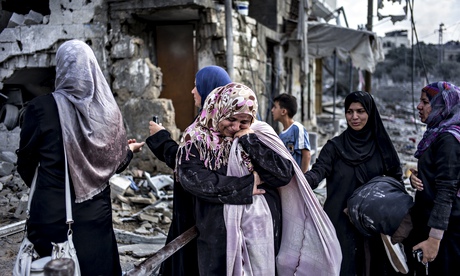
Palestinian women react to the destruction in Beit Hanuon, northern Gaza Strip, during the ceasefire. Photograph: Marco Longari/AFP/Getty Images
Thousands of people in Gaza have ventured out from homes and shelters during a 12-hour ceasefire to find that whole streets and neighbourhoods have been destroyed in the last week.
Israel and Hamas both agreed to a UN request to stop fighting from 8am until 8pm on Saturday. Shortly before the ceasefire took effect, at least 18 members of the al-Najar family, including many children, were killed in an air strike on Khan Younis, in the south of the Gaza Strip. The family had recently gone there to escape fighting in a nearby village, a Palestinian health official said.
As the Palestinian death toll in the 19-day-long conflict topped 1,000, diplomatic efforts to forge a longer ceasefire continued in Paris. Foreign ministers from seven nations – the US, France, Britain, Italy, Germany, Turkey and Qatar – called for an extension of Saturday's 12-hour humanitarian truce.
The group had convened, along with a senior EU representative, at the request of the US secretary of state, John Kerry, who failed to win Israeli or Hamas backing for a week-long truce on Friday. There were no envoys from Israel, Egypt or the Palestinian Authority.
"All of us call on the parties to extend the humanitarian ceasefire that is currently under way," the French foreign minister, Laurent Fabius, said.
In Gaza, scenes of devastation were discovered by those who returned to areas which had been the centre of particularly intense fighting, such as Shujai'iya, Beit Hanoun and around Khan Younis. Scores of homes were pulverised, roads were blocked with wreckage, and power cables dangled in the streets.
Many of those attempting to check the condition of their homes, retrieve possessions and, in some cases, search for the bodies of relatives seemed dazed by what they found. Some who had not seen each other for days embraced as they surveyed the wreckage around them. Ambulances with wailing sirens and donkey carts loaded with mattresses and pots clogged the streets.
In other areas, Palestinians rushed to stock up with food and essentials, and get cash from banks and ATMs, ahead of the Muslim holiday of Eid al-Fitr, which starts on Monday.
In Beit Hanoun, close to the border, Israeli tanks stood by as people searched through the debris for their belongings, packing whatever they could – blankets, furniture and clothes – into taxis, trucks, rickshaws and carts before fleeing the town.
Siham Kafarneh, 37, sat weeping on the steps of a small grocery store. The mother of eight said the home she had spent 10 years saving up for and moved into two months earlier had been destroyed. "Nothing is left. Everything I have is gone," she said.
Some people were defiant. One woman pulled a black-and-white Palestinian scarf from the rubble, shouting: "They won't take away our pride. We'll wear this to Jerusalem and the day of victory is close."
Others were resigned. Zaki al-Masri noted quietly that both his house and that of his son had been destroyed. "The Israelis will withdraw, tomorrow or the day after, and we'll be left in this awful situation as usual."
At the nearby hospital, six patients and 33 medical staff had spent the night huddled in the X-ray department as the neighbourhood was shelled, said the director, Bassam Abu Warda. A tank shell had hit the second floor of the building, leaving a gaping hole, and the facade was peppered with holes from large-calibre bullets.
Two Red Crescent ambulances were hit in Beit Hanoun overnight, killing a medic and wounding three, one critically, according to the International Committee of the Red Cross. On Saturday, rescue workers pulled the scorched body of the medic from the wrecked vehicle, which had been hit about 200 metres from the hospital.
"Targeting ambulances, hospitals and medical workers is a serious violation of the law of war," said Jacques de Maio, head of the ICRC delegation for Israel and the occupied territories.
In areas that had seen intense fighting, 85 bodies were pulled from the rubble, many of them partially decomposed, said Palestinian health official Ashraf al-Kidra. Fighters were also among the dead, said the Gaza Civil Defence spokesman Said al-Saoudi.
Speaking in Cairo on Friday, Kerry said he was confident there was a framework for a ceasefire agreement that would ultimately succeed and that "serious progress" had been made, although there was more work to do.
Kerry, who, along with UN secretary general Ban Ki-moon, has been leading international efforts to reach a truce, has been in regular contact with the foreign ministers of Turkey and Qatar as both countries wield influence on Hamas.
Israel's defence minister, Moshe Ya'alon, said on Friday that the military offensive could expand in the coming days. "At the end of the operation, Hamas will have to think very hard if it is worth it to taunt us in the future."
Israeli troops have so far uncovered 31 tunnels in Gaza and destroyed half of them. Israel considers the tunnels to be a strategic threat because militants have used them to launch surprise attacks inside the country.
The Israeli government has also begun suggesting that Gaza be demilitarised as a condition for a permanent ceasefire so that Hamas cannot rearm itself. The current war is the third in Gaza in just over five years.
Hamas says it will not halt its rocket until it receives international assurances that Gaza's seven-year-old border blockade will be lifted. Israel and Egypt tightened the blockade after Hamas seized Gaza in 2007.
The violence spread to the West Bank and East Jerusalem late this week. Nine Palestinians have been killed as protests over the bloodshed in Gaza have erupted into clashes with Israeli security forces. Hundreds more have been wounded, many with gunshot injuries.
On Thursday night, 10,000 demonstrators marched in solidarity with Gaza near the Palestinian administrative capital of Ramallah. Protesters surged against an Israeli army checkpoint, throwing rocks and Molotov cocktails.
The Palestine Liberation Organisation called for more demonstrations in the West Bank but said it was helping to try to secure a ceasefire deal.
As well as more than 1,000 dead in Gaza, at least 6,000 people have been injured. The UN said more than 160,000 people had sought shelter in its buildings, and thousands more had fled their homes to stay with relatives and friends in what are thought to be safer areas.
The Israel Defence Forces said 40 soldiers had been killed in the conflict. Three Israeli civilians have also died in rocket attacks.
138 جنديا إسرائيليا لا زالوا في المستشفيات بعضهم إصابتهم خطيرة جدا
عرب 48


أكدت مصادر إسرائيلية أن 138 جنديا لا زالوا يخضعون للعلاج في المستشفيات بينهم 7 أصيبوا بجراح خطيرة.
وقالت المصادر إن الخطر يتهدد حياة ثلاثة مصابين، في حين وصفت إصابة 4 منهم بأنها خطيرة، أما باقي الإصابات فتراوحت بين المتوسطة والطفيفة.
وقالت المصادر إن 4 جنود اصيبوا في قطاع غزة الليلة الماضية نقلوا إلى غرفة الطوارئ في مستشفى "هداسا" عين كارم، حيث يرقد هناك 15 جنديا مصابا. مضيفة أن ثمانية جنود آخرين أصيبو الليلة الماضية نقلوا إلى مستشفى "شيبا" في "تال هشومير" وإلى مستشفى "بيلنسون" في "بيتاح تكفا" أحدهم إصابته خطيرة.
وفي وقت سابق أعلن الجيش الإسرائيلي فجر اليوم، السبت، مقتل اثنين من جنوده في قطاع غزة، ليرتفع بذلك عدد قتلاه الجمعة إلى 4 جنود خلال 24 ساعة، وترتفع حصيلة قتلى الجيش في الحرب العدوانية على قطاع غزة إلى 37 جنديا، بحسب التقارير الإسرائيلية.
وكانت مصادر إعلامية لفتت يوم أمس إلى أن حملة احتجاج قام بها الجنود على إدخالهم لغزة بمدرعات غير كاملة التحصين، ألصقوا على أحدى المدرعات أسماء الجنود الذين قتلوا في غزة، والذي يشير إلى أن عدد القنلى تجاوز الـ 64 قيتلا منذ بدء الحملة البرية.
By the way, the number 64 matches closely the number of IOF fatalities published by Hamas. Coincidence? I don't think so. It simply shows that
Hamas is more credible than the IOF
Gaza ceasefire takes hold - in pictures
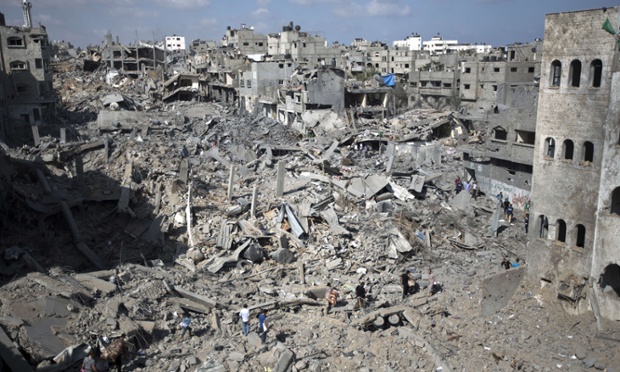
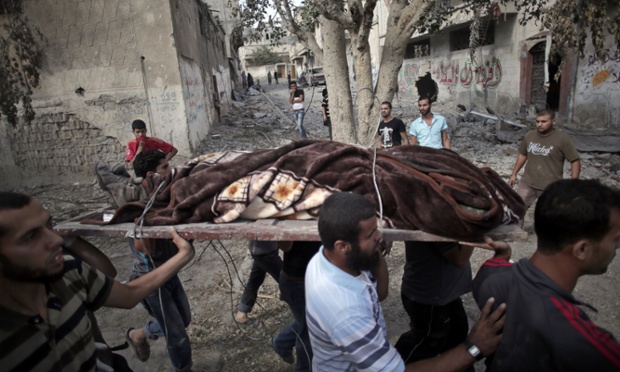
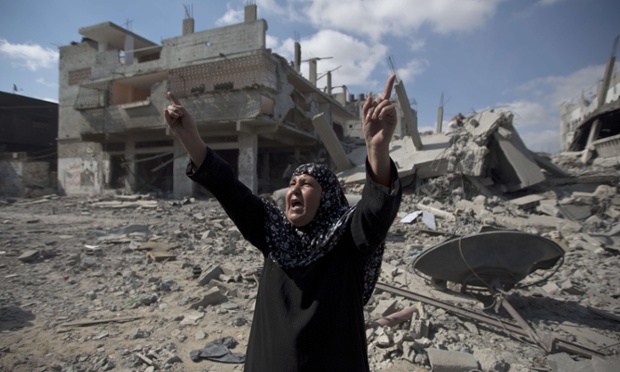
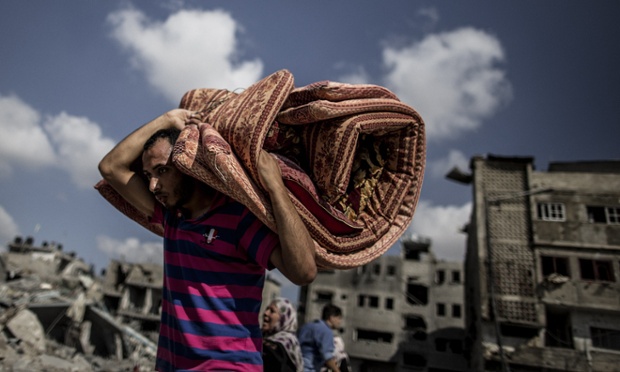
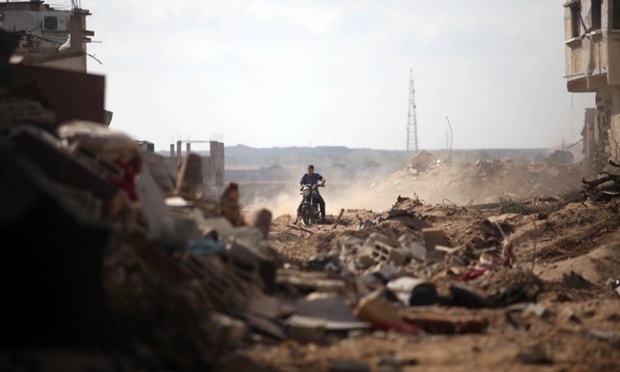
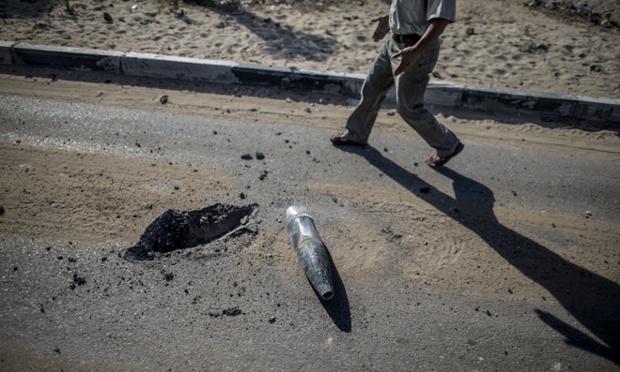
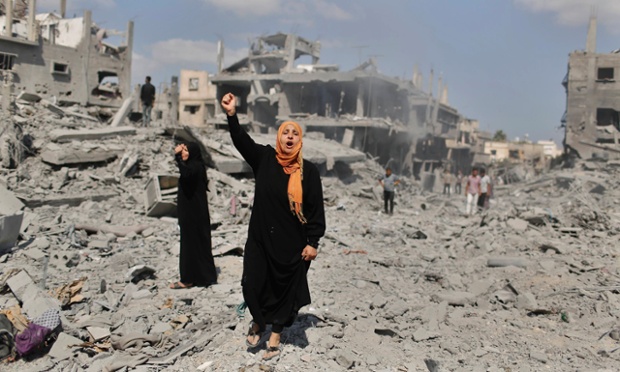
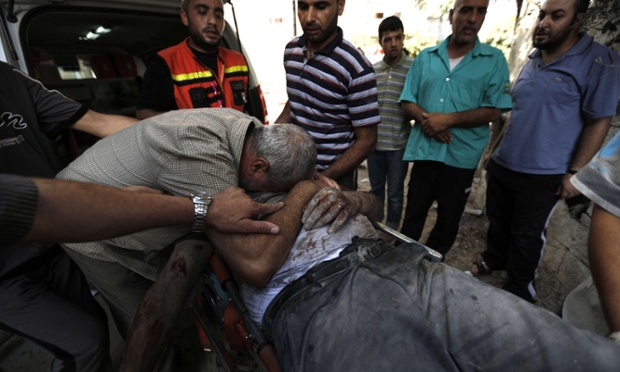
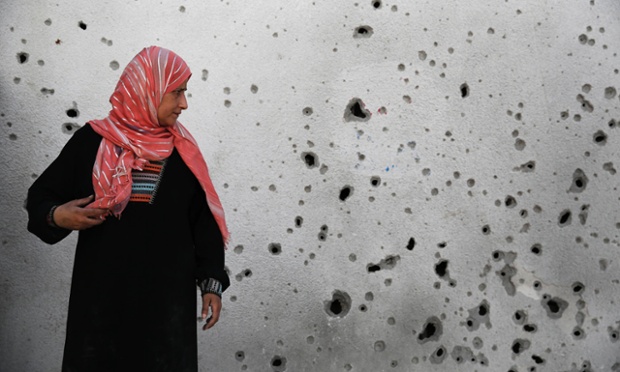
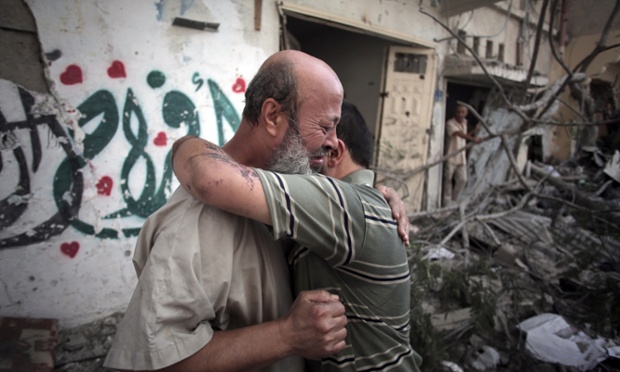
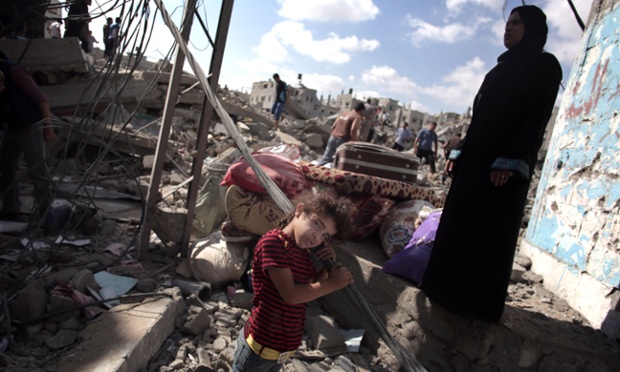
Friday, July 25, 2014
Middle East explodes into protest as Israeli onslaught on Gaza fuels anger
- Harriet Sherwood in Qalandiya
- The Guardian,
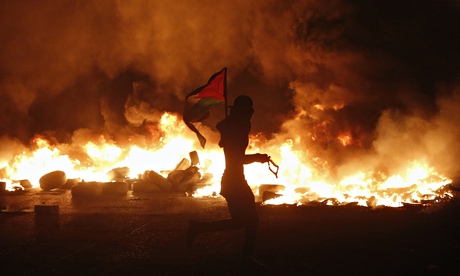
A protester holds a Palestinian flag at a barricade of burning tyres during clashes with Israeli troops at the Qalandiya checkpoint. Photograph: Mohamad Torokman/Reuters
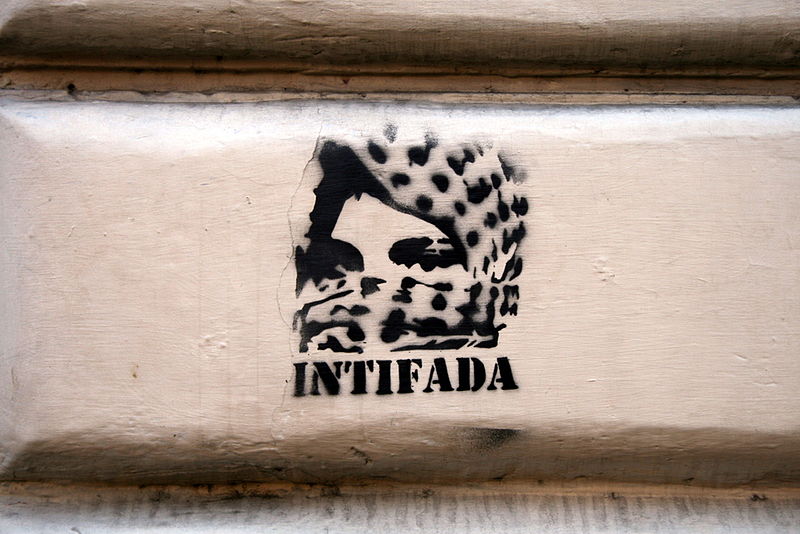
Ramallah doctor says 'We have seen this before but not since the intifada' as hospital treats 250 injured with gunshot wounds
On his 17th birthday, instead of celebrating at home with his family, Mohammed al-Araj made the fateful decision to join thousands of others on the West Bank in a protest over spiralling civilian deaths in Gaza, 50 miles away. As the violence that has consumed that tiny strip of land for the past 18 days ignited in the West Bank and East Jerusalem, Araj met his own premature and brutal end.
The young chef from Darna, one of Ramallah's best known restaurants, was shot dead in clashes between protesters and Israeli forces at the notorious Qalandiya checkpoint. At his funeral on Friday, squeezed between the noon prayers and the start of more confrontations, a family friend said he had seen Araj's body in the morgue. "No one could recognise him – the bullet had destroyed his face," said Raja Hananiya, 37, adding that he was "a nice boy, always smiling and joking".
Outside the Qalandiya refugee camp, where Araj was buried on the final Friday of the Muslim holy month of Ramadan, fresh tyres for burning had been placed on the main road leading to the checkpoint amid rubble, broken glass, scorched debris and the spent live ammunition cases from the night before.
By mid-afternoon, at least five more Palestinians had been killed, bringing the death toll to seven, and Ramallah's public hospital, already reeling from the 250 or so injured people who were brought in on Thursday night, was braced for a fresh influx.
Nearly all the injuries were gunshot wounds to the head, chest, stomach and limbs, and four or five people were still in intensive care, said a doctor in the hospital's emergency department, who was not authorised to speak to the media. "Ambulances were coming every minute. We have seen this before but not since the intifada," he said, referring to the Palestinian uprising from 2000 to 2005.
Thursday night's protest against the Israeli military onslaught in Gazaand the rising civilian death toll was the largest seen in the West Bank since the second intifada, with estimates varying from 10,000 to 25,000. Unusually, women, children and the elderly joined the march from Ramallah to Qalandiya, where some tried to breach the heavily manned checkpoint in an effort to reach Jerusalem.
"We went to show solidarity with the people of Gaza," said Mahmoud Amar, 27. "We are very angry about what's happening in Gaza –specifically the shelling of the [UN] school, and the killing of civilians in general."
But, according to Amar and others, the protest also reflected the mounting frustration of Palestinians in the West Bank over the continued Israeli occupation and diminishing hopes for a Palestinian state. "People are exploding," said Amar.
The gym trainer said he had no political affiliation, but support for Hamas was "up about 200%". The militant group's resistance to Israel's military campaign "is giving us a boost, bringing pride and dignity to our people," he said, adding that he would join protests again "today and everyday".
As Araj's body, wrapped in a Palestinian flag and adorned with flowers, was carried aloft from the mosque to the cemetery, Mohammed Assaf, 15, struggled with crutches and a bandaged leg to keep up with the crowd.
He had been throwing stones at soldiers at the checkpoint when they opened fire with live ammunition. A bullet fragment struck his leg. "Everybody joined the protest. There was no one left in the camp," he said. "Hamas are heroes."
On Friday, four Palestinians were killed in clashes with Israeli security forces, and a fifth appeared to have been shot dead by a settler.
Two, aged 21 and 22, were shot during a protest in the village of Hawara near Nablus in the north of the West Bank, said Mazen al-Hammouz, director of the city's Rafidiyeh hospital. Another three, one aged 47 and another 27, were shot in Beit Omar, near the city of Hebron, in the south.
In Iran, hundreds of thousands of people took part in nationwide rallies in solidarity with Palestinians. Images showed demonstrators holding banners, such as one reading "Stop killing babies in Gaza." A group of demonstrators set fire to Israeli flags and carried effigies of Israeli and American politicians.
Iran's president, Hassan Rouhani, was among many senior officials who participated in rallies.
Earlier in the week a group of prominent opposition activists in Iran, many of whom have endured lengthy jail terms in recent years, protested in support of Gaza in front of the UN offices in Tehran. The celebrated film-maker Jafar Panahi was among them.
Iran's Nobel peace prize laureate, Shirin Ebadi, a lawyer and human rights activist who currently lives in exile, also expressed serious concerns.
"Deliberate targeting of civilian areas by anyone is a violation of international law," she said in a joint statement signed by other female Nobel laureates. "Israel's continuing collective punishment of the Palestinian people because of its ongoing war of attrition against Hamas is a war crime."
About 2,000 people protested in Jordan's capital, Amman, after Friday prayers, chanting: "We sacrifice our blood and souls for you, Gaza" and "Bomb and destroy Tel Aviv". Protests were held in the northern cities of Zarqa and Irbid as well as in the south, in Karak.
Back in the Ramallah hospital, extra medical staff had been called in and operating theatres prepared for another night of violence. "We are ready," said the young emergency doctor as another ambulance screeched to a halt outside with its siren blaring.
Gaza crisis: Deadly force used on West Bank protesters as barrage of Gaza continues - live
The Guardian

".....A UN team had to cut short a visit to the scene of Thursday's attack on a school in Beit Hanoun when it encountered gunfire, UNRWA spokesperson Chris Gunness says in a statement. The Israeli army had been notified of the mission in advance, he says:
At 1400 today an UNRWA team which included an international weapons expert went to the school at Beit Hanoun which came under attack yesterday causing multiple deaths and injury. The aim of the visit to the site was to survey the scene in the aftermath of the incident. The Israeli army had been notified in advance about the composition of the team, the time and purpose of the visit. The mission had to be cut short and the team was forced to leave the area after gunfire around the school. UNRWA regrets not being able complete even this initial assessment. We will attempt to visit the site when the situation allows. We again underline our call for an immediate and comprehensive investigation......"

".....A UN team had to cut short a visit to the scene of Thursday's attack on a school in Beit Hanoun when it encountered gunfire, UNRWA spokesperson Chris Gunness says in a statement. The Israeli army had been notified of the mission in advance, he says:
At 1400 today an UNRWA team which included an international weapons expert went to the school at Beit Hanoun which came under attack yesterday causing multiple deaths and injury. The aim of the visit to the site was to survey the scene in the aftermath of the incident. The Israeli army had been notified in advance about the composition of the team, the time and purpose of the visit. The mission had to be cut short and the team was forced to leave the area after gunfire around the school. UNRWA regrets not being able complete even this initial assessment. We will attempt to visit the site when the situation allows. We again underline our call for an immediate and comprehensive investigation......"
Subscribe to:
Posts (Atom)






